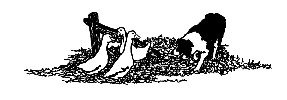Thank you, Val.
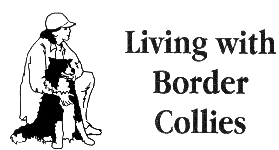
For centuries the Border Collie has toiled tirelessly in service to us. As the premier herding dog in the world, he has gathered large flocks from great distances and found lost stock in the worst of weather. But more than just a herding dog, he has been a war dog, a therapy/assistance dog, a sled dog, a competitive sport dog, a search and rescue dog, even a hunting dog, and always a companion dog. Whatever we have asked the Border Collie to do, he has done. He has never wavered, never faltered, never quit, never said "no" to his human partner. It is time for us to return the favor.
It is the mission of Border Collie Rescuers to ensure that Border Collies find homes where they are loved, cared for, and given the opportunity to work at what they do best, whatever that may be. It is also our mission to ensure that the people who come to know these wonderful dogs also come to understand them and their unique qualities, for it is in education that the salvation of the breed lies. Lastly, we must work in harmony with all facets of the Border Collie community to ensure that the needs of the dog take precedence over the competitive and commercial pursuits of people. Border Collies have given their all to us. Border Collie Rescuers strive with an equal amount of zeal and effort to protect these dogs and to secure the quality of life in their futures.
Border Collie Rescue Organization, Inc. Mission Statement
�
A Brief History of the Border Collie
Border Collies have been selectively bred for intelligence and working ability. To herd sheep in the Highlands of Scotland, a Border Collie needs to meet certain criteria. He needs to be independent enough to make his own decisions when at a distance from the shepherd. He needs to control his predator instincts so that he protects the sheep instead of killing them for food as his wolf ancestors have done. He needs the stamina to work in heat or cold, up and down steep hills, and to ignore minor injuries in the course of a workday. He also needs to be bred with a desire to work with his human companion, whether at a great distance or side by side to save a newborn lamb.
�
Breed Standards
Border Collies are bred for herding ability, not for looks. This means that a Border Collie can be anywhere from 25 pounds to 65 pounds. Their coat can be rough (long coat), semi-rough, or smooth (short-haired). The coat colors are extremely varied. The typical look is black & white, but Border Collies are also red & white, tri-colored (brown, black & white), blue merle, red merle, yellow, and sometimes predominantly white with small amounts of brown, black, and/or red. The eye colors range from amber to dark brown. Blue eyes also occur. One brown eye and one blue eye is not unusual. The ear carriage can be pricked, semi-erect, dropped, or a combination. The bone structure ranges from lightweight & graceful to a more heavy-boned & majestic look.

In herding, Border Collies circle and stalk the object of interest. The herding pose is head and forelegs lowered, eyes intense, tail down with bottom third of tail upturned. They can become focused on any moving object, even tiny insects. It's an attitude toward life and work, not looks, that distinguishes a dog as being a Border Collie.
�
Health Problems
This breed can be subject to a variety of inherited diseases like progressive retinal atrophy, canine hip dyplasia, and deafness. Some have epilepsy and endocrine diseases, with unknown inheritance factor. Allergies and skin conditions also occur.
Because Border Collies are extremely active, they are prone to athletic injuries such as pulled muscles, cuts and punctures, ripped toenails and footpads. Keep a first-aid kit and your vet's phone number handy. The dog also requires a yearly booster shot, heartworm test and preventative, rabies vaccine, license, spay/neuter, and quality dog food.
Border Collie Puppy Checklist
- Are you prepared for a long, sometimes hectic, puppy stage? If not, you might consider adopting an adult rescued Border Collie (these dogs were usually sold to homes unprepared for a Border Collie's activity level).
- Can you understand the pup's pedigree? If not, find someone who knows local Border Collie breeding, and can check the pedigree.
- Do you understand why you need to see the paperwork of the parents for OFA (hip x-rays and certification) and eye certifications?
- Did you ask the breeder why these parents were selected for breeding?
- Did the breeder question you about your reasons for wanting a Border Collie?
- Does the breeder seem to care or are the pups strictly business?
- Is their "den" clean?
- Are the pups at least 8 weeks old? Have the pups been given their first shots and been de-wormed?
- Are the parents well-behaved and reasonably friendly towards your family?
- Have you watched the parents working?
- Have the pups been raised in a constantly expanding environment, with exposure to all types of adults, children, other animals, indoor and outdoor living?
Puppies are priced from $300-$600. Good puppies are expensive to breed and raise and should be priced accordingly. A pup advertised in your local newspaper for $50 is not a bargain but may be a temperament and health disaster. If you wouldn't be comfortable returning a pup to his breeder, don't buy from that breeder in the first place.
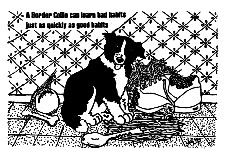 Crate-training is strongly recommended for the protection of your new
puppy. As the pup learns the rules of your home, he can be trusted to behave
for longer periods of time.
Crate-training is strongly recommended for the protection of your new
puppy. As the pup learns the rules of your home, he can be trusted to behave
for longer periods of time.
When outside, the new Border Collie should be in a fenced area or on a long line and supervised to prevent mishaps. Supervision will also help in training the new dog. A simple "No" or "Ah-Ah" will stop your dog from digging holes, barking too much, chewing up your shrubs, trying to herd sparrows, etc.
Socializing your new Border Collie is very important. Teach your dog how you want him to greet people. A simple "Sit-Stay" until guests are ready to play with your dog will impress your friends and family with your dog's manners and your training ability.
�
Recommendations for house-training
After the puppy has been confined in a crate 2 to 3 hours (4 to 6 hours for adults):
1. In a quiet up-beat manner, take him on leash to the bathrooming area.
2. Choose a bathrooming phrase you are comfortable with and say the phrase a few times. Keep this as low-key as possible. If the dog can't run around to investigate interesting smells, he'll go to the bathroom out of sheer boredom.
3. If the dog does his "business" within 10 to 15 minutes, say, "Good (bathrooming phrase)", then play fetch, give him a treat, or let him romp around in his fenced-in yard.
4. If he doesn't "go" take him back to the crate for another half hour, then try again.
Your Border Collie will quickly learn that the fun part of his day doesn't begin until after he's been a "good" dog outside. For more information about crate-training, read
GOOD OWNERS, GREAT DOGS by Brian Kilcommons
�
Misunderstood Border Collie Traits
If your Border Collie is already nipping at people's heels or hands, say, "Ouch!" in a growling tone of voice and totally withdraw your attention from the dog for 5 minutes.
If your Border Collie encounters a situation that frightens him, do not pet and console him. Instead, keep an upbeat attitude and tell him to get over it. Continue walking as if nothing bad is happening, or ask the dog to do a sit-stay until the situation is over. Give some light praise for good, brave behavior. On the other hand, being afraid of certain things can save your dog's life. In my neighborhood, hunting season is dangerous. I taught my dogs to be afraid and to run to the house for safety when they hear gunshots.
It's easy to unintentionally teach a Border Collie to be possessive of food or toys. The puppy gives a bark or growl, so you back off in surprise. To prevent this, play a game with your Border Collie. When your pup has a toy, ask him to "drop it", then give him a treat. If he guards his food bowl, ask him to "sit", then add a few treats to his supper. Don't put the dog bowl in a corner because it can also set up food guarding.
Border Collies have play growls and real growls. Play growls normally occur while the dog is shaking a floppy toy or playing tug-of-war. To teach tug-of-peace, read
DOGS LOVE TO PLEASE...WE TEACH THEM HOW! by September Morn
If you don't find jobs for your Border Collie, he'll find his own. And most of the time you won't like the jobs your Border Collie finds! Border Collies' more annoying jobs can be things like herding squirrels, cornering cats and holding them there for hours, digging giant craters in the backyard, or whining and pushing at people constantly. Border Collies' more dangerous jobs can be herding cars (which is extremely dangerous as they try to get vehicles to change directions), swooping out at people and ferociously barking at the same time which can be misinterpreted as viciousness, or herding owners which could lead to a nasty fall. Border Collies love to work. They were born to work. They won't love and respect you unless you participate with them in work.
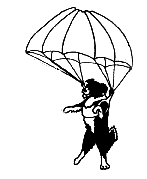
The term "work" doesn't necessarily mean herding livestock.
Work is an attitude, not a specific task. Obedience competitions, agility
events, frisbee contests, flyball, visits to nursing homes, throwing a tennis
ball in the backyard can all be considered work by your Border Collie. Observe
the dog; if his body position is in a working pose, then he considers that
particular task to be work. Add sits, downs, pauses, that'll do's, and so
forth into the routine. This is the only key needed for living with Border
Collies.
Basic Border Collie Manners
Name recognition Say the dog's name, then give him a treat. Keep repeating this as often as it takes for the dog to start turning his head whenever he hears his name.
RecallUse the leash in the house, a long-line outside. Say the dog's name to get his attention, then an upbeat "Come!". If he doesn't turn around immediately, give a light tug on the line. When the dog comes, give praise, a treat, and a hug. Make recalls the best thing in your dog's life. If the dog is slow on recalls, take a few running steps backward after calling the dog.
Praise Ask the dog to do something, like a sit. When he's sat, tell him "Good sit". The use of praise with the request gives the dog a chance to learn faster. Also, give him praise for figuring out on his own what he should do. If we remember to praise him for thinking,we help him to be a mannerly dog on his own and not just a robot. Quietly praise as the dog begins the correct action so as not to disturb or confuse him.
Correction To stop an action, give a "No!" or an "Ah-Ah!" noise in a growly tone. The most effective correction is given while the dog is still thinking about the action. The next best thing is during the action. Might as well forget about it if the correction is given after the action. A stronger correction is the "No!" combined with stomping your foot in front of the dog. A much stronger correction is a roaring "No!" combined with rushing at the dog (used for things like chasing cars). A correction is useless if it isn't followed by a short lesson on the proper action.
Jumping Teach the dog to sit for attention. If the dog already has a habit of jumping on people, say "Off!" and block the dog from jumping by putting your knee up (this is not to hit the dog in the chest, but to block the dog from your body). Do not shove the dog off with your hands, that's giving him what he wants. Withdraw your attention from the dog until he sits. To reinforce the sit, hunker down to the dog's level a few times.
Barking Respect your dog by investigating why he is barking. If it's something he shouldn't be barking at, just walk away from him in a disappointed manner, muttering about how stupid he is (Border Collies hate being called stupid). If he barks appropriately, praise him. Allow your dog to bark 2 to 3 times before saying "Enough!" and give him a treat. (It's hard to bark and swallow at the same time!) The result is a trustworthy watchdog.
Naptime Give yourself and your Border Collie a break now and then. Say "Go to bed" and throw a treat into the crate, kennel, or dog-proofed room. Teach him with short sessions in confinement at first until the dog learns he isn't being permanently abandoned.
Sit & Down Raise a treat slowly over the dog's nose and say "Sit". The rump should go down as the nose comes up. When the dog knows sit, then slowly tap a treat along the floor in front of the dog's nose as you're dragging out the word "Down".
That'll do! Every time a job is finished, say "That'll do". This will teach the Border Collie to leave off and come to you. It can also be used to break up a job. For example, if the dog is 'working' a frisbee, give a "that'll do", walk away a bit with your dog, then tell him "frisbee", and continue working. Use this with anything the dog is herding, be it sheep, tennis balls, the neighborhood squirrels. He will respond better to a "that'll do" than a recall if he takes off after something.
Training tips for working with Border Collies
Voice is extremely important. Pitch the voice high and quick to speed up a Border Collie. Lower the pitch and drag out the words to slow him down. For corrections, lower the voice even more and say the words in a growly tone. Most of the time, talk to a Border Collie in a normal conversational tone.
To bring a Border Collie towards you, move away from him. To push him away, move towards him. Hunker down and move slightly to one side to pull a Border Collie all the way to your side.
Let your emotions show through your eyes to your Border Collie's eyes. To show disappointment, look at your Border Collie and then deliberately look away. If the Border Collie isn't paying attention, throw up your hands and walk away. He'll come up to you and ask for another chance.
Border Collies like a chance to think new things over in relative quiet. Use an hour of 'peace & quiet' after lessons for any Border Collie, rescue or raised in one home from a pup, and the results will be quicker and steadier learning.
Tie your dog's 6' leash to your belt when teaching the Border Collie a daily chores routine. Whether his chores include picking up laundry scattered around the house or as company while you're feeding and watering the livestock, learning the routine while "attached" to you is the easiest way to teach him.
Some Border Collies will use submissive behavior to manipulate and control us. Others will bark and carry on like they're having a temper tantrum. Still others will use every expression and gesture you have ever found cute to get their own way.
Observe your dog, then train to his strengths and weaknesses; training just begins with the above recommended books. Find or adapt a training method that's enjoyable for you and your Border Collie.
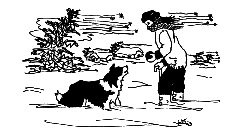
Border Collies are bred to be workaholics. They don't care if the weather is brutal. They don't care if they are in pain. They don't care if you were just released from intensive care. If he's not worked or exercised, he will feel and act punished.
If you jog with your Border Collie during the summer, expect to do the same the year round. If neglect continues long enough, your Border Collie will tell you in some unpleasant way that the punishment is unfair. The dog may start chewing your furniture, barking in your face, or leaving a bowel movement exactly where you step out of bed.
On the other hand, if your Border Collie starts acting like you are his slave, work can deliberately be taken away from him. For example, if playing frisbee is the dog's main focus in life, go play frisbee without him. The part of this trick that will shock your dog is make sure he can see you! Either let him watch from the house (while he's supervised) or tie him about 6' from you. Don't over-use this trick as it is mentally hard on the dog.
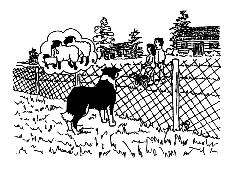
Herding the neighborhood kids and giving an occasional light nip to a rear end or ankle might seem like a funny game. But do you really want your Border Collie treating people as if they are sheep?
Certainly you want your Border Collie to play with children, but herding games can get serious if the dog and a child have different ideas of where the child should be. Border Collies and children can have a terrific relationship---as long as an adult or the kids are controlling the games.
Border Collies are great at soccer, frisbee, softball, tetherball, touch football, basketball, etc. But first, to teach the Border Collie who's in charge, have the children help with obedience lessons or taking the dog for a controlled, heeling-type walk. Once the Border Collie learns to heel, small children can take the dog for a walk by the child using an 18" leash while an adult chaperones the lesson with a 6' leash attached to the collar.
Working with Rescued Border Collies
Peace & Quiet. The first steps to a new life for a Border Collie is 3 to 7 days of 'peace & quiet' and a different name (see page 5). This technique is based on the work of C. W. Meisterfeld, but adapted by BCRO to specifically work for Border Collies.
The new Border Collie stays in a Vari-Kennel away from other dogs and from the noise of household activity. Only one person works with the dog during this stage. Let the Border Collie out, on leash, 4 to 5 times a day, for fifteen to thirty minutes each time. This technique is hard on people (especially for a family who've just adopted a Border Collie from their local shelter), but it works like a re-birth into a better life for the dogs. The dog learns to trust the person who is the source of all water, food, directions, encouragement, and hugs.
Isolation gives the Border Collie a chance to learn the different environment in a relaxed, safe atmosphere. His brain has the chance to stay calm and receptive to new lessons. He has a chance to grieve or recover from his previous life experiences. Teach the dog as if he's an 8-week old pup: use clear instructions and encouragement. This is also a good time to start housetraining and teaching basic manners. The most important thing to remember is to set the dog up for success every time he's with people.
The amount of 'peace & quiet' is determined by the dog's reactions. The dog should be happy, but not hysterical. He should have a calmness in the eyes and show enthusiasm for being with someone. A desire to learn will appear in the dog's posture and response time. When this happens, the dog goes into regular lessons and normal crating or kenneling conditions for at least 6 weeks.
Safety. The new Border Collie may try to run away or chase something at first. To keep him safe, use a bright-colored 6' nylon leash (loop cut off) with your phone number written in large numbers across the leash. (Use a permanent marker.)
If your Border Collie does happen to get away from you, don't chase after him! Instead, try to catch his eye, then run away from him. Unless he's been severely punished for poor recalls, he should come right to you. Then praise him to the skies, even though you'd rather shout at him and shake him for scaring you so much!
Training crook. Use 5' length, 3/4" diameter PVC pipe, capped on one end. Pour in 1/8 cup of BBs, cap other end. This crook is effective for herding, breaking up dog fights, eliminating food-guarding, and other times when the dog isn't listening. A sharp tap on the ground in front of the dog's legs startles the dog without scaring him. A quiet word of encouragement will refocus the dog on listening and working with you.
For more information about working with rescues and shelter dogs, read
THE ADOPTION OPTION by E. Rubenstein and S. Kalina
THE SECOND-HAND DOG by Carol Lea Benjamin
Herding with Border Collies
An inexperienced handler, inexperienced Border Collie, and non-dogbroke livestock is a combination leading to at least one of the 3 species getting hurt. Invest some time and money in learning before taking a new dog into the field.

Training help is available in a variety of ways. Sending your dog to a professional trainer or purchasing a started dog will cost more money than time. You still need to invest the time to learn what your dog already knows. Other ways take more time than money, like herding clinics, herding books, and videos.
At first, the expense of a started dog, herding clinics, books, videos, or the purchase price of a puppy or rescue doesn't seem worth the bother. But the investment will eventually pay off in time saved and chiropractor bills avoided!
Carefully choose the right disposition of Border Collie for your livestock. A calmer, level-headed dog is just right for a small dairy herd (as long as he has the spunk or training to nip wayward cows). A dog with great stamina and dive-in style is good for chasing geese away (as long as the dog is trained not to hurt the geese). It's best to observe your livestock to determine how they can be moved with the least amount of stress.
It's also important to understand what type of dog you enjoy working with. An easy, people-pleasing temperament is the right type of Border Collie to work with young 4-H students. People who can't help but yell and stomp around a bit when they are frustrated would be better off with a more dominant personality dog who won't take the yelling personally. If, after you've done all the right research, you still end up with the wrong Border Collie for you or your livestock, contact the breeder or your local rescuer to find a new, more appropriate home for your dog. Chalk it up to experience and keep looking.
Recommended training and history information for new enthusiasts:
LESSONS FROM A STOCKDOG by Bruce Fogt (book)
HERDING DOGS: PROGRESSIVE TRAINING by Vergil Holland (book)
COME BYE! AND AWAY! by H. Glyn Jones (video)
TRAINING AND WORKING DOGS by Scott Lithgow (book, mainly about cattlework)
THE WORKING BORDER COLLIE (magazine)
14933 Kirkwood Rd; Sidney, Ohio 45365
(one year subscription $30 US; $40 Canada; $40 Europe; $52 Europe Airmail; US Funds only)
SHEEPDOGS AND THEIR MASTERS by John Herries McCullough, updated by Dee Woessner
KEY DOGS FROM THE BORDER COLLIE FAMILY by Sheila Grew
 Some Border Collie Personalities
Some Border Collie Personalities
A dominant personality will need reasons for doing everything. He will always be testing the boundaries you've set. He will be the quickest to protest if you withhold work for some reason. He can also be the dog you depend on the most---if you've earned his respect and trust. Recommended training book for a dominant personality:
DOG LOGIC, COMPANION OBEDIENCE by Joel M. McMains
A shy personality will need lots of encouragement. Give a shy dog at least three days to adjust to new situations and training. Don't give up on socializing this type of dog, but always start new training in a quiet environment. Gradually work up to loud, stressful situations. This Border Collie will be your emotional support when you've had a bad day. Recommended training book for a shy personality:
OWNER'S GUIDE TO BETTER BEHAVIOR IN DOGS by William E. Campbell
A pouting personality can be either frustrating or amusing. This dog will quit and lie down in a corner if things don't go his way. Just ignore him for awhile---even pouters are workers and will come around. These dogs are amusing in their antics to get their own way. Recommended training book for a pouting personality:
PLAYTRAINING YOUR DOG by Patricia Gail Burnham
A watching personality will stand back to observe everything before deciding to join the activities. You won't realize the dog is learning until he amazes you with his new skills. Just remember, this dog both watches good and bad, then looks for your reactions, so don't laugh if another dog steals food from the table. Recommended training book for a watching personality:
HOW TO TEACH A NEW DOG OLD TRICKS by Dr. Ian Dunbar
Border Collie Rescue Organization, Inc. (BCRO)
We are a group of rescuers, foster providers, and volunteers working together to help individual Border Collies in trouble and to provide educational materials to prevent Border Collies from being placed in shelters and rescue groups. BCRO volunteers helped assemble and edit the materials contained in this pamphlet, but Val Maurer is responsible for the final content and any errors contained in this pamphlet. Due to space considerations, not all Border Collie organizations have been listed in this pamphlet, but all groups can be found in "Working Border Collie" magazine. This pamphlet may be copied in entirety only, and we encourage its distribution for local events. Other Border Collie Rescue groups can request a copy of BCRO's camera-ready artwork. (We'll add poster and return address changes for you.) For excerpt permission, contact Val Maurer at 1-888-THATLDO or [email protected]
BCRO accepts Border Collies from owners, shelters, and other rescuers. Some rescues are pedigreed, some look & act purebred but have no verification, a few are known BC mixes. Rescues are 1 to 3 years old, on average, but we do receive seniors on occasion. Puppies are being abandoned at an alarming rate; BCRO almost always has puppies in rescue this year.
ADOPTING AN ADULT BORDER COLLIE
BCRO matches families with Border Collies of compatible temperament and abilities. Adopters don't have to hope their dog will like kids, with an adult dog we know if the Border Collies like children, herding, agility, obedience, etc. An adult dog will bond with a new family. Dogs seem to know when they've been 'saved' and have a deep desire to work with the new people in their lives.
BCRO ADOPTION APPLICATION INFORMATION
ADVICE FOR KEEPING A BORDER COLLIE
BCRO can help if you are having training or behavior problems with your Border Collie. We don't want Border Collies in rescue if it can be prevented. There is no set fee for consultations for Border Collies: donations appreciated.
BCRO FOSTER HOMES & VOLUNTEERS
If you want to help Border Collies, call 1-888-THATLDO on Fridays (from Thursday midnight to Friday midnight EST) for more information.
Foster homes are screened and trained before acceptance. Volunteers are needed for transporting dogs, shelter checks, distributing posters & pamphlets, writing articles,training for herding, obedience, agility, and much more! We have an apprenticeship stage of up to six months before BCRO membership.
BCRO rescues are spayed/neutered before adoptions.
We request an adoption donation to help defray some of our rescue costs.
Living with Border Collies printed May 1995, revised and reprinted February 1997. Revised for BCRO website November 1997
Printing costs for "Living with Border Collies" 2/97 edition donated by Justine Nathan and the Festoon Foundation.
This pamphlet is dedicated to the memory of Paul Swinehart. He taught me how to love other people's cast-off dogs. He also taught me how to make or repair most of what I need, how to let go, how to laugh, when to fight, and the art of swearing.
I also want to acknowledge Duke and Laddie (Spaniel/Terrier mixes). Duke's death put a sorrow in me that attracts dogs in trouble. Laddie's blindness led me directly to Border Collies and starting BCRO.
Val Maurer
For Border Collie books & videos: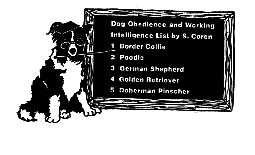
Border Collies in Action
1-800-833-0332
